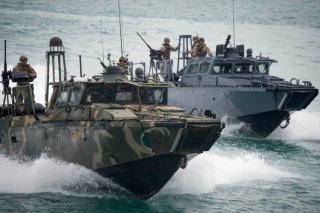Sink or Swim: Surface Combatants Need Air Defenses in the Drone Era
The lack of any anti-air systems on the Navy’s smallest surface combatants leaves them vulnerable to even the smallest armed drones.
On May 2, Ukraine’s Ministry of Defense claimed to have used its Bayraktar TB2 drones to destroy two Russian Project 03160 “Raptor” Patrol craft. To support this claim, the ministry of defense posted footage of the drone tracking and destroying the maneuvering vessels. While we can applaud the Ukrainian forces on their tactical success, the success of the TB2 drones against patrol craft brings up significant questions regarding the survivability of smaller naval vessels, especially those not equipped with any form of air defense systems. The video of the Ukrainian TB2 operator calmly tracking and destroying a frantically maneuvering but defenseless ship should disturb every navy leader. If small- to medium-sized armed drones can easily detect and destroy small surface combatants as the Ukrainians did, then all small naval vessels without active air defenses are susceptible to these tactics.
U.S. Navy officials should be especially concerned about Avenger-class minesweepers, Cyclone-class patrol ships, Mark VI patrol craft, and the Navy’s array of smaller patrol craft and riverine combatants. The lack of any anti-air self-defense mechanisms aboard the Navy’s smallest surface combatants leaves these ships vulnerable to even the smallest armed drones and utterly dependent on larger surface combatant escorts. Furthermore, the tactical reality demonstrated by Ukrainian forces should inform the designs of the new class of Medium and Large Unmanned Surface Vessels currently being developed by the U.S. Navy.
This is not to suggest that every ship must have an advanced, multi-layered suite of missiles and guns. However, vessels should not be defenseless and dependent on escorts for their protection. Equipping smaller naval vessels with anti-air systems similar to the SIMBAD system, a navalized French Mistral anti-air missile, would deter and prevent adversaries from using inexpensive equipment and tactics such as armed drones to sink smaller naval vessels. Likewise, for larger unmanned surface vessels, the SEARAM—a combination of the Phalanx Close-in Weapon System and the RAM missile—could serve the same purpose. In short, this would prevent American vessels from falling victim to the tactics Ukrainian forces effectively used against Russia.
These air defense systems would constitute a contemporary equivalent of the deck guns and depth charges that gave merchant vessels and small surface vessels a modicum of protection against air and submarine threats during the two World Wars. Without these armaments, U-boats and patrol craft simply surfaced and loitered alongside defenseless Allied merchant vessels, leisurely shelling and strafing the ships. The introduction of deck guns and depth charges added additional threats that deterred and at times even destroyed U-boats and aircraft that attacked small crafts and merchant vessels.
While the sinking of the Moskva was headline-grabbing, there are significant aspects of the Russo-Ukrainian War that indicate how a future naval conflict will unfold. Perhaps one of the most consequential is the effectiveness of armed drones against naval vessels without air defense systems. Navies that rely on these small vessels must better equip them with some level of air defense to avoid suffering the same fate as the Russian Raptor-class patrol craft.
Jeong Soo "Gary" Kim is an active-duty Civil Engineering Corps Officer in the U.S. Navy. He is the winner of the 2021 Marine Corps Essay Contest hosted by the U.S Naval Institute and is published in Proceedings, Marine Corps Gazette, and the Center for International Maritime Security (CIMSEC).
Image: Flickr/U.S. Navy.

